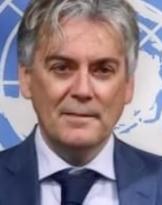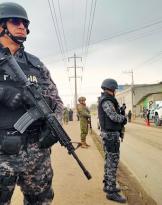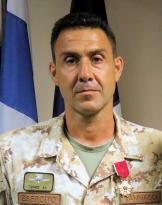"Taking a look at the history of jihadist attacks and the decisions of Osama Bin Laden to develop any biological and chemical attacks, we understand that the failure has been total".
Telling us about CBRN and possible attacks in Europe, starting from a historical excursus, is Dr. Ely Karmon, a political scientist, researcher at the International Institute for the Fight against Terrorism (ICT) and at the Institute for Policy and Strategy at the Center interdisciplinary (IDC) of Herzliya, Israel.
A former US Defense Secretary William Cohen declared in the 1995 that weapons of mass destruction (WMD), terrorism, and chemical, biological and nuclear weapons would be the main strategic threat to the United States in the twenty-first century. Fortunately, after the chemical attacks by the Japanese Aum Shinrikyo in the 1994-1995, that occurred in the United States in October 2001 and the al-Qaeda chlorine attacks in Iraq in the 2006-2007, there were no serious CBRN incidents in Worldwide. How serious is the threat of proliferation of chemicals today? And the threat of nuclear proliferation?
At his appointment in the 1995, Defense Secretary William Cohen presented the CBRN terrorist threat as the strategic threat to the United States in the twenty-first century, referring primarily to nuclear terrorism, although, most of the analyzes and researchers, considered the threat to "high risk" but with "very low probability".
After the fall of Communism, in the Soviet Union, there was concern that the huge national infrastructure, which included nuclear submarines, bombs and missiles, could fall into the hands of terrorists. This doesn't happen in real life for several reasons. There was a US-Russia agreement and most nuclear materials, including uranium and plutonium, were brought under control, while now independent countries like Kazakhstan and Ukraine sold their decommissioned nuclear weapons to the United States.
At the time it was rumored that Osama bin Laden wanted to buy twenty nuclear bombs from Kazakhstan. It was a blatant lie: the Russian government quickly understood the risks to society and its own interests and took steps to strengthen the security and defense of nuclear infrastructure, including the training of special forces to defend the plants. The police and security services in Russia, but also in the West, such as in Germany or Switzerland, therefore took action against sellers - or buyers - of nuclear materials and arrested them before anything serious could happen. These operations were advertised to deter others, criminals and terrorists, and not get involved in such deals.
Nuclear terrorism is still considered a very serious threat because such an event could endanger the very fabric of democratic societies, with enormous social and political consequences. For this reason, in the United States there is a very strict control of the flow of containers from abroad and every import from foreign ports must be controlled according to US customs rules and protocols, in order to minimize the risk that a device nuclear power can smuggle into United States territory.
In 2008, according to the US Commission on the Prevention of Proliferation and Terrorism of WMD (Weapon of Mass Destruction), 74% of the terrorism experts interviewed "considered Pakistan, the country most at risk of transfer of know-how of nuclear technology. to terrorists in the next three to five years. " Is this country still a threat?
As for the threat posed by Pakistan, I can say that it is still the main nuclear threat, because Pakistan has several nuclear facilities and an arsenal of around 80-100 bombs. Saudi Arabia has been involved in financing the Pakistani nuclear program and at the moment the Pakistani prime minister presented the project as an "Islamic bomb".
It should be remembered that the Pakistani nuclear scientist Bashiruddin Mahmood, former head of the Khushab plutonium reactor in Pakistan, had close ties with Al Qaeda and the Taliban. After 9 / 11 was arrested with other affiliates by Pakistan Intelligence (ISI) at the request of the US government. But then he was released.
Al-Qaeda leaders also attempted to contact the infamous Abdul Qadeer Khan's infamous clandestine nuclear weapons supply network that supplied Iran, North Korea and Libya with nuclear technology and know-how. These attempts were rejected by the Khan network.
Today, the main danger is posed by radical Pakistani jihadist groups, some of which were trained in the past by the Pakistani army and the Intelligence Services to fight India in Kashmir, which are now fighting their own government.
In the past decade, some terrorist attacks have occurred near nuclear facilities or infrastructure. Eight people were killed in a 2007 suicide bombing in the south of the Pakistani capital. Kamikaze in 2008 attacked the accesses of the Kamra Air Base in Pakistan (suspected nuclear bomb storage) and the Wah Cantonment (believed to be a nuclear weapons assembly plant). Two other high-profile attacks by terrorists on military bases deemed inviolable in Pakistan, the first at the Pakistani army headquarters in Rawalpindi in October 2009 and the second at the PNS Mehran Naval Air Force Base near Karachi , in May 2011, they renewed concerns about the safety of Pakistan's nuclear arsenal.
What needs to be taken into consideration, besides Pakistan, particularly in Europe, could be an attack on existing nuclear facilities, such as civil reactors. For this reason, in France, which has the largest number of nuclear power plants (49), there is an anti-aircraft battery network that protects the airspace above these plants. Flying over these areas is forbidden.
The 9/11 report from the Commission pointed out that both Mohammed Atta, one of the pilots, and Khalid Sheikh Mohammed, the mind of the attacks, had also targeted a nuclear plant. In the end they decided to avoid nuclear targets, probably because Osama bin Laden already feared the level of tremendous retaliation of the United States.
In October of the 2001, US officials interrupted the operations of the Three Mile Island plant in Pennsylvania for four hours and suspended flights in the neighbors airports, under a "credible threat" of terrorism. The alert returned to reveal a false alarm.
A threat arose in Belgium, where a senior BR-2 reactor officer at the Belgian Nuclear Research Center was the subject of clandestine video recordings by a suspected accomplice in the November 13, 2015 Paris terrorist attack. claimed 130 victims. Belgian police uncovered the material while searching the home of a person who had ties to the Islamic State terrorist group. Belgian authorities speculated that the group was trying to find a way to collect radioactive materials from the research center, possibly by kidnapping the senior official or one of his family members. A first step in building a bomb.
And what about countries like North Korea, Iran, Syria and Libya? These countries have been at the center of the issue over the past decade. Am I still a serious threat?
In the past, all rogue countries with nuclear infrastructure, even if not bombs, such as North Korea, Iran, Syria, Iraq, Libya, have been viewed as potential suppliers of chemical or nuclear weapons to terrorist organizations.
During the seven years of civil war, Syria, which had a huge chemical arsenal spread out in about fifty bases, lost control of some of these infrastructures. However, most of the known chemical attacks in Syria were staged by the Bashar al-Assad regime against military and civilian opposition, with chlorine and sarin.
In Iraq, even though in the 1990s most of the chemical plants were eliminated by international inspectors, the huge Al Muthanna CW complex was occupied by ISIS in the 2014. In destroyed underground structures probably had a certain amount of chemicals left, especially mustard gas. The first known chemical attack by the Islamic State was in July 2014, against the Kurds in the besieged city of Kobani, in northern Syria. Then followed other attacks on Kurdish Peshmerga forces in Iraq ...
Former experts of Saddam Hussein of chemical war were active in the ranks of ISIS. Salih Jasim Muhammed Falah al-Sabawi (also known as "Abu Malik"), a chemical weapons expert who joined ISIS in the 2005 was killed in January 2015 in a targeted US attack near Mosul. He had worked at the Muthanna Chemical Weapons Production Plant and was known as a mid-level fighter who provided means to develop chemical weapons.
Sulayman Dawud al-Bakkar (Abu Dawud), considered the "Emir" of chemical weapons production, who had previously worked for Saddam Hussein's regime, was captured by US special forces in Iraq. It provided information that enabled bombing of ISIS chemical weapons storage and manufacturing facilities, as well as the personnel employed.
Last week Putin declared that the biggest risk for Europe (and in particular for Russia)è the use of "low-power" nuclear weapons. Can the Islamic State carry out chemical or biological terrorist attacks in Europe?
If we take a look at the history of the attacks, jihadists and Osama Bin Laden's decisions to develop biological and chemical attack projects, the failure was total. The only serious work was carried out by a Malaysian commander, a member of AQ, also involved in the preparation of the 11/XNUMX attacks: he tried to build a laboratory first in Afghanistan and then in Indonesia. He was arrested and the projects dismantled.
The main threat, as mentioned earlier, is today in Iraq and Syria. Even though the 90% of the Syrian chemical arsenal has been destroyed through a Russian-American agreement in 2013, the regime still has some resources and could go back to producing new chemicals. Nothing is known publicly on the Syrian "biological project".
There is a potential threat of chemical transfer to Europe, but this is a very difficult operation even for ISIS or al-Qaeda. There have been some attempts in Germany similar to the Belgian incident (documents on a German nuclear plant were found at the Brussels apartment of Paris bomber Salah Abdeslam), in Kosovo (ISIS planned to poison the city's water supply of Pristina) and in Australia (release of hydrogen sulfide on a scheduled flight), but none were accomplished. The problem is that even minor tactical attacks can have enormous social and political effects.
In a report dated 2012 he wrote that, according to Robert S. Litwak, a terrorist group could acquire a nuclear weapon from a foreign state, from an unauthorized transfer or through a theft to a badly protected facility. It is still a hypothesis valid?
In my opinion, the main immediate threat is an attack on existing structures. For example, in the October 2001 explosion at a very important chemical facility in Toulouse, France, thirty people were killed and 2000 injured. At the time, reports came in that it was a terrorist attack. More recently, in June 2015, a truck driver - already under surveillance for links to radical Islamic circles - crashed into an American-owned chemical warehouse in southeastern France and hung his employer's severed head. I work at one of the gates. The perpetrator tried to open containers containing flammable chemicals before being blocked. A French security official said the bomber would apparently wrong calculations in the mixing of substances.
Similarly to the danger of chemical terrorism, the radiological one is also present, with a "dirty" bomb. The social and political consequences could be even greater.
The terrorist threat with a nuclear weapon, as already explained in this interview, is really very low.












